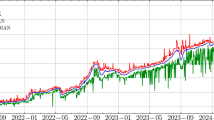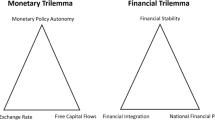Abstract
Using US data for the period 1967:5-2002:4 this paper empirically investigates the performance of a Fed funds rate reaction function (from now on, FRF) that (i) allows for the presence of switching regimes; (ii) considers the long–short term spread in addition to the typical variables; and (iii) uses an alternative monthly indicator of general economic activity suggested by Stock and Watson (J Monet Econ 44:293–335, 1999). The estimation results show the existence of three switching regimes, two characterized by low volatility and the third by high volatility. Moreover, the scale of the responses of the Federal funds rate to movements in the rate of inflation and the economic activity index depends on the regime. The estimation results also show robust empirical evidence that the importance of the term spread in the FRF has increased over the sample period and the FRF was more stable during the term of office of Chairman Greenspan than in the pre-Greenspan period.
Similar content being viewed by others
References
Aït-Sahalia Y (1996) Testing continuous-time models of the spot interest rate. Rev Financ Studies 9: 385–426
Ang A, Bekaert G (2002) Short rate non-linearities and regime switches. J Econ Dyn Control 26: 1243–1274
Ang A, Bekaert G (2002) Regime switches in interest rates. J Bus Econ Stat 20: 163–182
Barth M, Ramey V (2001) The cost channel of monetary transmission. In: Bernanke B, Rogoff K (eds) NBER Macroeconomics Annual. MIT Press, Cambridge, pp 199–239
Bec F, Ben-Salem M, Collard F (2002) Asymmetries in monetary policy reaction function: evidence for U.S. French and German central banks. Studies Nonlinear Dyn Econ 6(2):Article 3
Carey K (2001) Testing for stabilizing monetary policy rules: how robust to alternative specifications? The B.E. J Macroecon (Topics) 1(1):Article 3
Clarida R, Galí J, Gertler M (1999) The science of monetary policy: a new Keynesian perspective. J Econ Lit 37: 1661–1707
Clarida R, Galí J, Gertler M (2000) Monetary policy rules and macroeconomic stability: evidence and some theory. Q J Econ 115: 147–180
Cooley T, LeRoy S, Raymon N (1984) Econometric policy evaluation: note. Am Econ Rev 74: 467–470
Dolado J, María-Dolores R, Naveira M (2005) Are monetary-policy reaction functions asymmetric? The role of nonlinearity in the Phillips curve. Eur Econ Rev 49: 485–503
Dolado J, María-Dolores R, Ruge-Murcia F (2004) Nonlinear monetary policy rules: some new evidence for the U.S. Studies Nonlinear Dyn Econ 8(3):Article 2
Estrella A, Hardouvelis G (1991) The term structure as a predictor of economic activity. J Financ 46: 555–576
Estrella A, Mishkin F (1997) The predictive power of the term structure of interest rates in Europe and the United States: implications for the European Central Bank. Eur Econ Rev 41: 1375–1401
Evans C, Liu C, Pham-Kanter G (2002) The 2001 recession and the Chicago Fed national activity index: identifying business cycle turning points. Economic Perspectives, Federal Reserve Bank of Chicago 26, third quarter, pp 26–43
Fama E (1990) Term structure forecast of interest rates, inflation and real returns. J Monet Econ 25: 59–76
Fisher J (2000) Forecasting inflation with a lot of data. Chicago Fed Letter, Federal Reserve Bank of Chicago (March), p 151
Gerlach-Kristen P (2004) Interest rate smoothing: monetary policy inertia or unobserved variables? The B.E. J Macroecon (Contribut) 4(1):Article 3
Hamilton J (1994) Time series analysis. Princeton University Press, New Jersey
Leeper E, Davig T (2006) Fluctuating macro policies and the fiscal theory. In: Acemoglu D, Rogoff K, Woodford M (eds) NBER Macroeconomics Annual. MIT Press, Cambridge, pp 247–298
Leeper E, Sims C, Zha T (1996) What does monetary policy do?. Brooking Pap Econ Activ 2: 1–78
McCallum B (1994) Monetary policy and the term structure of interest rates. NBER Working Paper no. 4938
Mishkin F (1990) The information in the longer maturity term structure about future inflation. Q J Econ 105: 815–828
Rotemberg J, Woodford M (1998a) An optimization-based econometric framework for the evaluation of monetary policy: expanded version. NBER Technical Working Paper Series no. 233
Rotemberg J, Woodford M (1998b) Interest-rate rules in an estimated sticky price model. NBER Working Paper Series no. 6618
Rudebusch G (2002) Term structure evidence on interest rate smoothing and monetary policy inertia. J Monet Econ 49: 1161–1187
Sims Christopher, Zha T (2006) Were there regime switches in US monetary policy. Am Econ Rev 96: 54–81
Stock J, Watson M (1999) Forecasting inflation. J Monet Econ 44: 293–335
Svensson L (1997) Inflation forecast targeting: implementing and monitoring inflation targets. Eur Econ Rev 41: 1111–1146
Taylor J (1993) Discretion versus policy rules in practice. Carnegie-Rochester Series Public Policy 39: 195–214
Valente G (2003) Monetary policy rules and regime shifts. Appl Financ Econ 13: 525–535
Vázquez J (2004) Switching regimes in the term structure of interest rates: a case for the Lucas proof equilibrium? Studies Nonlinear Dyn Econ 8(1):Article 5
Walsh C (2003) Monetary theory and policy. MIT Press, Cambridge
Author information
Authors and Affiliations
Corresponding author
Rights and permissions
About this article
Cite this article
Vázquez, J. Does the term spread play a role in the fed funds rate reaction function? An empirical investigation. Empir Econ 36, 175–199 (2009). https://doi.org/10.1007/s00181-008-0191-4
Received:
Accepted:
Published:
Issue Date:
DOI: https://doi.org/10.1007/s00181-008-0191-4




